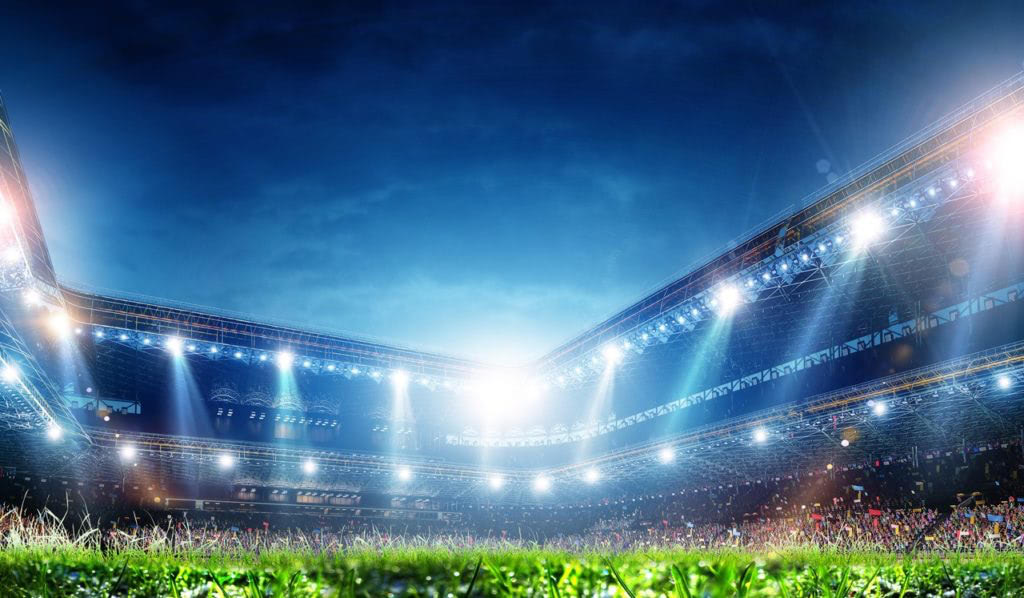One evening in late Sept. 1892, spectators squinted through the dimly-lit fog to see a group of men jostling on the field below. It was the first recorded football game played at night. Edison’s carbon-thread incandescent lamps provided the light, but not particularly well. The game was stopped at the midway point due to low visibility.
Since then — well over 100 years ago — outdoor stadium lighting has improved dramatically. Many sporting events, from local football games to NASCAR races, are held at night. Improvements to outdoor sports lighting have allowed more fans to experience events, as they can take place later in the day when spectators aren’t at work.
Outdoor Sports Lighting Has Changed
First came the improvements in power; lights became bigger and brighter. Then, outdoor stadium lighting was refined. Today, outdoor sports lighting has become a science of its own. Lighting designers take much into account when developing a lighting plan for a stadium; they must consider beam angles, light pollution, and countless other factors. One factor of the utmost importance is the lighting system’s lenses.
3 Benefits of Quality Glass for Outdoor Lighting Applications
- Durable & Low Maintenance
Outdoor sports lighting is constantly exposed to the elements. Opting for lighting systems that use durable glass and can withstand continuous exposure to salt, fog, humidity, and other environmental conditions without deterioration will quickly reveal itself as being a high-value investment. Lower quality lenses will need maintenance sooner and more frequently, and in the case of stadium lighting, that’s not as simple as stepping onto a stool to replace a lightbulb.
- Optimal Light Transmission
The quality of the glass used in outdoor sports lighting will impact the viewer experience of the events, as well as the bottom line of the venue. For example, Vista AR® Post-Temperable Glass has the ability to accurately transmit light, without degradation, and is flexible enough to be molded or tempered into lenses for spotlights—demonstrating light transmission up to 99%.
- Heat Resistant & Temperable
Glass is highly heat resistant, which allows the glass to undergo heat treatments and tempering without risking the integrity of its light transmission or degrading the material. Tempering can strengthen glass and its heat resistance is crucial for outdoor sports lighting applications where lenses may be subject to high temperatures from lamps for prolonged periods of time. This is why glass is often the superior choice when compared to alternatives like polycarbonate. Its wideband coating is designed to withstand the intense heat of the tempering process.
Find High-Quality Glass or Acrylic for Your Outdoor Sports Lighting Project
Durable glass that can withstand harsh weather and abrasion while maintaining a high level of light transmission leads to a well-lit, safe stadium and low maintenance costs and can’t be overlooked in outdoor sports lighting projects. In fact, acrylic may be the right solution for your application as it offers similar properties in lighting applications. Lens quality can improve a viewer’s experience while saving the stadium’s management time and money through maintenance costs.
Reduce Glare, Gain Light Transmittance & Increase Energy Efficiency
Tru Vue’s Vista AR® Post-Temperable Glass is engineered to perfectly minimize reflection on glass over the visible spectrum while offering light transmission up to 99%. Its proven durability in outdoor conditions makes it ideal for stadium lighting’s prolonged exposure to outdoor elements and heat. In addition, Vista AR® Post-Temperable Glass has a special, enduring, anti-reflective coating that allows more light through creating a better experience for stadium goers and energy efficiency for stadium owners.
For more information on Tru Vue’s Vista AR® Post-Temperable Glass, product specifications, and additional key features, contact us today.
Additional Reading
Share this Article:
This article is intended for educational purposes only and does not replace independent professional judgment. Statements of fact and opinions expressed are those of the author(s) individually and, unless expressly stated to the contrary, are not the opinion or position of Tru Vue or its employees. Tru Vue does not endorse or approve, and assumes no responsibility for, the content, accuracy or completeness of the information presented.
